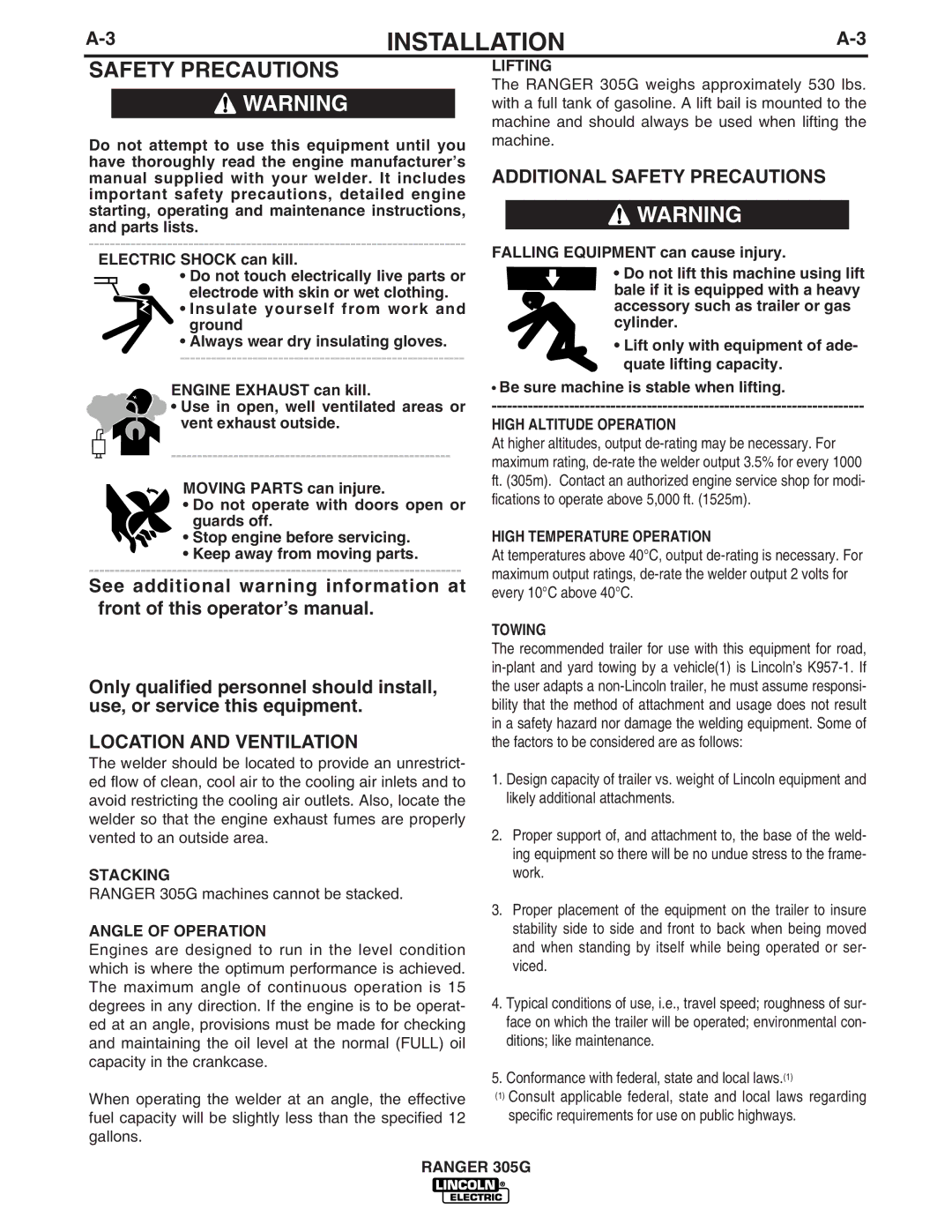
INSTALLATION | ||
|
|
|
SAFETY PRECAUTIONS
![]() WARNING
WARNING
Do not attempt to use this equipment until you have thoroughly read the engine manufacturer’s manual supplied with your welder. It includes important safety precautions, detailed engine starting, operating and maintenance instructions, and parts lists.
ELECTRIC SHOCK can kill.
• Do not touch electrically live parts or electrode with skin or wet clothing.
•Insulate yourself from work and ground
•Always wear dry insulating gloves.
ENGINE EXHAUST can kill.
• Use in open, well ventilated areas or vent exhaust outside.
MOVING PARTS can injure.
•Do not operate with doors open or guards off.
• Stop engine before servicing.
•Keep away from moving parts.
See additional warning information at front of this operator’s manual.
Only qualified personnel should install, use, or service this equipment.
LOCATION AND VENTILATION
The welder should be located to provide an unrestrict- ed flow of clean, cool air to the cooling air inlets and to avoid restricting the cooling air outlets. Also, locate the welder so that the engine exhaust fumes are properly vented to an outside area.
STACKING
RANGER 305G machines cannot be stacked.
ANGLE OF OPERATION
Engines are designed to run in the level condition which is where the optimum performance is achieved. The maximum angle of continuous operation is 15 degrees in any direction. If the engine is to be operat- ed at an angle, provisions must be made for checking and maintaining the oil level at the normal (FULL) oil capacity in the crankcase.
When operating the welder at an angle, the effective fuel capacity will be slightly less than the specified 12 gallons.
LIFTING
The RANGER 305G weighs approximately 530 lbs. with a full tank of gasoline. A lift bail is mounted to the machine and should always be used when lifting the machine.
ADDITIONAL SAFETY PRECAUTIONS
![]() WARNING
WARNING
FALLING EQUIPMENT can cause injury.
•Do not lift this machine using lift bale if it is equipped with a heavy
accessory such as trailer or gas cylinder.
• Lift only with equipment of ade- quate lifting capacity.
•Be sure machine is stable when lifting.
HIGH ALTITUDE OPERATION
At higher altitudes, output
HIGH TEMPERATURE OPERATION
At temperatures above 40°C, output
TOWING
The recommended trailer for use with this equipment for road,
1.Design capacity of trailer vs. weight of Lincoln equipment and likely additional attachments.
2.Proper support of, and attachment to, the base of the weld- ing equipment so there will be no undue stress to the frame- work.
3.Proper placement of the equipment on the trailer to insure stability side to side and front to back when being moved and when standing by itself while being operated or ser- viced.
4.Typical conditions of use, i.e., travel speed; roughness of sur- face on which the trailer will be operated; environmental con- ditions; like maintenance.
5.Conformance with federal, state and local laws.(1)
(1)Consult applicable federal, state and local laws regarding specific requirements for use on public highways.
